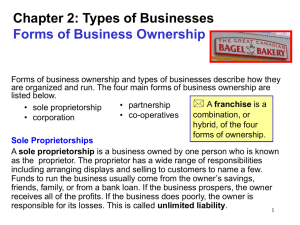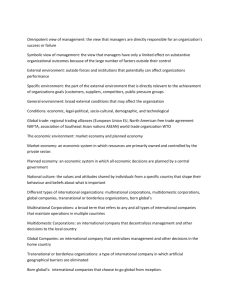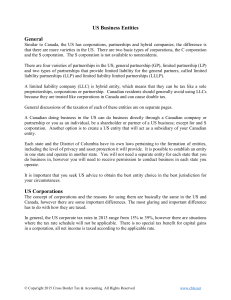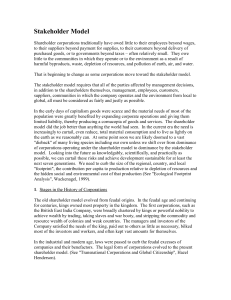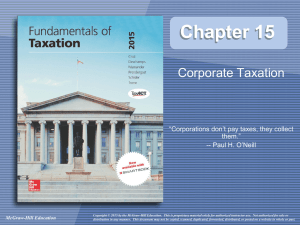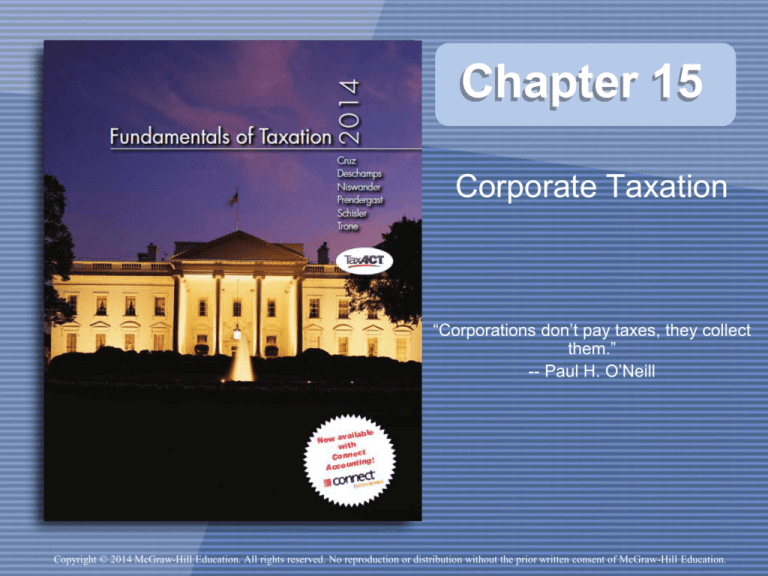
Chapter 15
Corporate Taxation
“Corporations don’t pay taxes, they collect
them.”
-- Paul H. O’Neill
Copyright © 2014 McGraw-Hill Education. All rights reserved. No reproduction or distribution without the prior written consent of McGraw-Hill Education.
LO #1 Corporate Formation and Filing
Requirements
• Corporations are legal entities formed
under the laws of a state.
• Corporations can use the cash-basis of
accounting if average gross receipts <=
$5 million or if inventory is not a material
factor.
15-2
LO #1 Corporate Formation and Filing
Requirements
• Corporations are not limited to a
calendar year fiscal year. They can
choose any fiscal year in their first year
of operation.
• Corporations file a Form 1120.
• Tax returns are due 2.5 months after the
fiscal year-end
– Can obtain an automatic 6-month
extension.
15-3
LO # 2 - Basis
• On formation of a corporation,
transferors are exchanging cash and/or
property for stock.
• Generally, on corporate formation, no
gain is recognized by the transerors if,
immediately after the transfer, the
transferors control 80% or more of the
corporation.
15-4
LO # 2 - Basis
• Two cases in which gain may be
recognized by the transferor(s):
– 1. If shareholder contributes an asset
subject to a liability and the relief of liability
is greater than basis
– 2. Boot received triggers gain equal to the
lesser of the boot received or the gain
15-5
LO # 2 - Basis
• Basis of the contributed property to the
corporation (inside basis)
– Equal to the basis in the hands of the
shareholder plus any gain recognized by
the shareholder
15-6
LO # 2 - Basis
• Basis of the stock to the shareholder
(outside basis)
– Equal to the basis of the property
contributed, plus any gain recognized,
minus any boot received (boot includes any
relief of liability).
• Unless shareholder increases or
decreases his or her proportionate
ownership, generally outside basis does
not change.
15-7
LO #3 – Taxable Income & Tax Liability
• Determination of taxable income
generally follows the rules associated
with a trade or business (Chapter 6).
– For corporations, the notion of AGI does
not exist.
15-8
LO #3 – Taxable Income & Tax Liability
• Capital gains and losses are netted
together.
• Net capital losses are not permitted.
– If a corporation has a net capital loss, it can
carry it back three years and then forward
five years.
• Only offsets net capital gains in the carryback or
carryforward periods.
• Net capital gains are included in income
and are taxed at ordinary rates.
15-9
LO #3 – Taxable Income & Tax Liability
• Charitable contributions are limited to
10% of taxable income before charitable
contributions, DRD, and carrybacks.
– Excess is carried forward five years.
• Contribution amount for “ordinary
income property,” such as inventory, is
limited to basis.
15-10
LO #3 – Taxable Income & Tax Liability
• Corporations receive a Dividends
Received Deduction (DRD) for dividends
from other domestic corporations.
– DRD is 70% if ownership is < 20%
– DRD is 80% if ownership => 20% or < 80%
– DRD is 100% ownership => 80%
• DRD may be limited.
15-11
LO #3 – Taxable Income & Tax Liability
• Organizational expenses and start-up
expenses can be amortized and
deducted over 180 months
– Corporation must make affirmative election.
– Some org expenses and/or startup
expenses may be immediately deductible.
15-12
LO #3 – Taxable Income & Tax Liability
• Taxable income is subject to tax rates of
up to 35%.
– Tax rate schedule is progressive, but the
benefit of lower rates for lower income is
recaptured as taxable income increases.
15-13
LO #3 – Taxable Income & Tax Liability
• Corporations must make estimated
payments
– Payment is lesser of 100% of tax due for
the year or 100% of the tax for the prior
year.
– Due on 15th day of fourth, sixth, ninth, and
twelfth months of fiscal year.
– Underpayment penalty applies if payments
are not sufficient.
15-14
LO #3 – Taxable Income & Tax Liability
• If a corporation has a net operating loss,
it can be carried back two years and
then carried forward 20.
– Corporations can make an irrevocable
affirmative election to carry the NOL only
forward.
15-15
LO #4 – Transactions with Shareholders
• Corporations have earnings and profits
(E&P). Similar, but not identical, to
retained earnings
– E&P is based on tax law, not accounting
rules
• Distributions of cash or property from
E&P are dividends
– Taxable to shareholders
– Not deductible by the corporation
15-16
LO #4 – Transactions with Shareholders
• Distributions in excess of E&P
– Nontaxable to shareholder to the extent of
shareholder basis in the stock
– A capital gain to the extent the distribution
exceeds basis.
15-17
LO #4 – Transactions with Shareholders
• Distribution of property with FMV in
excess of basis
– Corporation reports gain (write-up to FMV)
– Amount of distribution to shareholder is
based on FMV.
15-18
LO #4 – Transactions with Shareholders
• Distributions in full liquidation
– Corporation records all assets and liabilities
at FMV and records gain or loss
– Shareholder reports capital gain or loss
equal to the FMV of the distribution
compared to stock basis.
15-19
LO #5 – Schedules L, M-1 and M-3
• Schedules L, M-1, and M-2 are all on
page 5 of the Form 1120.
– Small corporations are not required to
complete these schedules.
• Schedule L is a beginning and ending
balance sheet reported in accordance
with the financial accounting method of
the corporation.
15-20
LO #5 – Schedules L, M-1 and M-3
• Schedule M-1 is a reconciliation from
book income to taxable income (not the
other way around).
• Schedule M-1 sets forth all book/tax
differences for the year, whether
permanent or temporary.
15-21
LO #5 – Schedules L, M-1 and M-3
• Some items that are a positive
adjustment (added back) from book
income to taxable income:
– Income tax expense per books
– Excess capital losses
– Disallowed current year charitable
contribution
– Book depreciation in excess of tax
depreciation
– 50% of travel and entertainment expense
15-22
LO #5 – Schedules L, M-1 and M-3
• Some items that are a negative
adjustment (subtracted) from book
income to taxable income:
– Life insurance proceeds
– Tax exempt interest
– Tax depreciation in excess of book
depreciation
– Charitable contributions in excess of 10%
limit in prior year
15-23
LO #5 – Schedules L, M-1 and M-3
• Schedule M-3 is a comprehensive
book/tax reconciliation for large
corporations.
– Total assets of $10 million or more.
15-24
LO #6 – Other Corporate Issues
• Parent-subsidiary group
– A common parent owns, directly or
indirectly, at least 80% of one or more other
corporations.
– Can elect to file a consolidated return.
– If elected, the election is irrevocable for all
future tax years.
15-25
LO #6 – Other Corporate Issues
• Brother-sister group
– Five or fewer persons own two or more
corps
• Total ownership test – group owns at least 80%
of the voting shares
• Common ownership test – group has common,
identical, ownership of at least 50% of share
value
– Must disclose to IRS.
15-26
LO #6 – Other Corporate Issues
• Larger corporations are subject to AMT
– Start with taxable income, add or subtract tax
adjustments, add tax preference items, subtract
exemption amount.
– Preferences similar to individuals
• Additional corporate item is the adjusted current earnings
(ACE) adjustment
– Exemption amount is $40K
• Phased out 25 cents on the dollar for AMT income over
$150K. Exemption is totally phased out for AMT income
of $310K or more.
– AMT rate is 20%
15-27
LO #7 – Subchapter S Corporations
• Subchapter S corporations are “regular”
corporations that elect to be taxed in a
manner similar to a partnership
• File a Form 1120S
• Filing deadlines and extension rules are
the same as Subchapter C corporations
15-28
LO #7 – Subchapter S Corporations
• Must meet four tests to elect Sub S
status:
– Be a domestic corporation
– Have 100 or fewer shareholders
– Have one class of stock
– Have shareholders who are U.S. citizens or
resident aliens.
15-29
LO #7 – Subchapter S Corporations
• Sub S corporations report taxable
income and separately stated items
– Separately stated items are very similar to
those reported by a partnership
• Sub S corporation does not pay tax.
The shareholders do.
15-30
LO #7 – Subchapter S Corporations
• Shareholder basis is determined similar
to a partnership except corporate debt
does not affect shareholder basis.
• Basis increased by:
– Net income
– Separately stated positive items
– Capital contributions
– Loans from the shareholder to the
corporation
15-31
LO #7 – Subchapter S Corporations
• Basis is decreased by:
– Net losses
– Separately stated negative items
– Distributions from the corporation at FMV
• Basis cannot go below zero.
– If negative basis is implied, the amount is
carried forward.
15-32
LO #7 – Subchapter S Corporations
• Subchapter S distributions are not
taxable to shareholders
– Shareholders have already been taxed on
the income
– Similar to a partnership in that income is
taxed and distributions are generally not
taxed.
15-33






